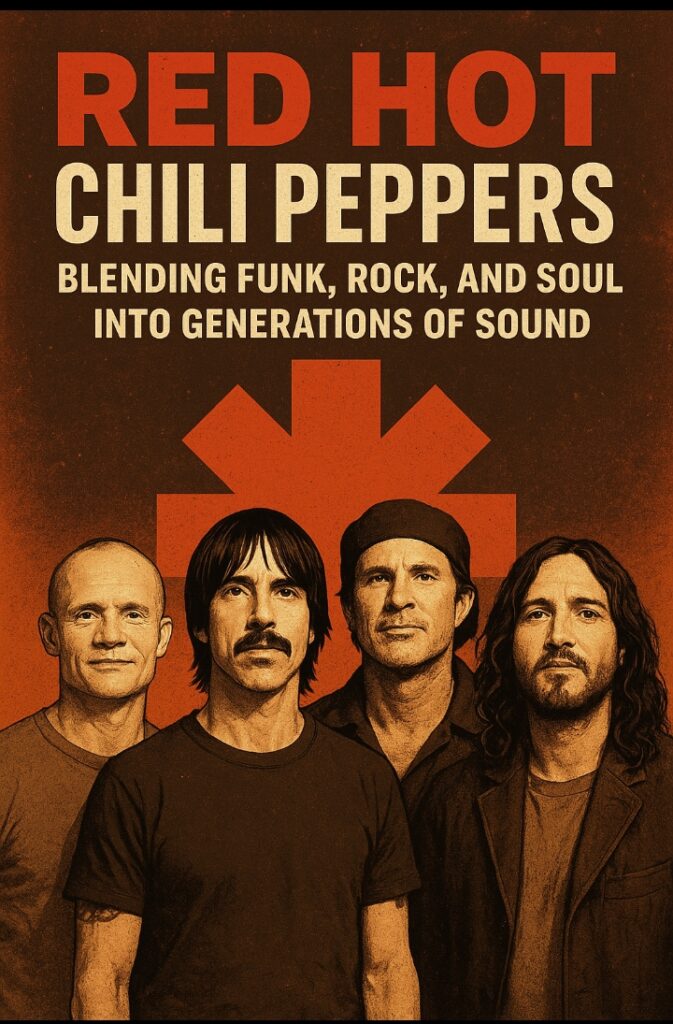Red Hot Chili Peppers: Blending Funk, Rock, and Soul into Generations of Sound
Red Hot Chili Peppers: Blending Funk, Rock, and Soul into Generations of Sound
For over four decades, the Red Hot Chili Peppers have remained one of the most dynamic and enduring bands in the world of rock music. Their sound—an explosive mix of funk, punk, soul, and psychedelic rock—has not only shaped alternative music but also inspired generations of artists and fans across the globe. Formed in Los Angeles in 1983, the group’s original lineup—Anthony Kiedis, Flea, Hillel Slovak, and Jack Irons—embodied the raw, rebellious energy of the city’s underground scene. Their early music was fueled by unfiltered passion, a relentless drive to experiment, and an unshakable bond between friends. Despite the personal losses and lineup changes that would follow, the Red Hot Chili Peppers have consistently evolved while staying true to their roots—creating a sound that is instantly recognizable, deeply emotional, and always alive with rhythm.
At the core of the band’s success is the unique chemistry between its members, particularly frontman Anthony Kiedis and bassist Flea. Kiedis’s distinctive vocal delivery—half-rap, half-melody—perfectly complements Flea’s virtuosic, funk-inspired basslines. Together, they built a musical foundation that transcends genre boundaries. When guitarist John Frusciante joined the band in 1988, his melodic sensitivity and emotional guitar work added depth and texture, propelling the group toward greater artistic maturity. His interplay with Flea created a distinctive sonic tension—both aggressive and soulful—that became the band’s signature. Drummer Chad Smith, who joined in 1989, completed the lineup with his powerful and precise drumming, giving the Chili Peppers the rhythmic backbone that would carry them through decades of evolution.
The band’s breakthrough came with the 1991 release of Blood Sugar Sex Magik, produced by Rick Rubin. The album was a game-changer, combining raw funk rhythms with introspective lyrics and unforgettable hooks. Songs like “Give It Away” and “Under the Bridge” showcased the band’s versatility—moving effortlessly between wild energy and heartfelt vulnerability. “Under the Bridge,” in particular, revealed a new emotional depth in Kiedis’s songwriting, turning the group from a cult favorite into mainstream icons. The record not only solidified their place in music history but also influenced countless bands that followed, proving that rock could be both funky and poetic, rebellious yet deeply human.
As the years went on, the Red Hot Chili Peppers continued to evolve musically and emotionally. Albums such as Californication (1999), By the Way (2002), and Stadium Arcadium (2006) reflected a more mature and reflective band. Californication marked the band’s triumphant rebirth after years of turmoil, blending dreamy guitar melodies with themes of redemption, love, and loss. Tracks like “Scar Tissue,” “Otherside,” and the title song displayed Frusciante’s ethereal guitar tones and Kiedis’s introspective lyrics, offering listeners a glimpse into the band’s personal growth. By the Way further expanded their sound palette, layering lush harmonies and experimental arrangements while maintaining their infectious grooves. Stadium Arcadium, a double album, celebrated their musical legacy by embracing both the funk-driven spirit of their early days and the melodic sophistication of their later work.
Beyond their studio albums, the Red Hot Chili Peppers are best known for their electrifying live performances. Their concerts are an explosion of energy—Flea’s acrobatic stage presence, Kiedis’s charismatic delivery, and the tight synergy between all members create an atmosphere of pure exhilaration. Each show feels spontaneous, with extended jams and improvisations that showcase the band’s deep musical connection. Their ability to maintain such energy after decades of performing is a testament to their passion and respect for their craft. Fans across continents continue to fill stadiums, drawn by the band’s authenticity and the timeless power of their music.
Lyrically, Kiedis’s work has evolved from youthful exuberance and streetwise storytelling to introspective reflections on love, addiction, and personal growth. His journey mirrors the band’s—marked by struggle, recovery, and renewal. Flea, meanwhile, has become not only one of the most respected bassists in rock history but also a passionate advocate for music education. His fusion of funk, punk, and jazz influences redefined the role of the bass guitar, making it a lead instrument rather than a supporting one. John Frusciante’s guitar playing, characterized by its emotional restraint and melodic precision, adds a haunting beauty to the band’s sound. Together, they form a creative synergy that is rare in modern music—a constant push and pull between intensity and tenderness.
What makes the Red Hot Chili Peppers truly exceptional is their ability to stay relevant while remaining authentic. In an industry defined by trends, they have never chased commercial formulas or abandoned their artistic core. Each album feels like an evolution rather than a reinvention—a natural progression of their musical and emotional journey. Their 2020s releases, Unlimited Love and Return of the Dream Canteen, proved that the Chili Peppers still have more to say, blending nostalgic warmth with fresh creativity. These albums reunited the classic lineup with Frusciante and recaptured the spark that made the band legendary.
Ultimately, the legacy of the Red Hot Chili Peppers is one of resilience, reinvention, and rhythm. They’ve weathered personal tragedy, industry changes, and cultural shifts while continuing to create music that resonates across generations. Their blend of funk, rock, and soul is more than just a genre—it’s a philosophy of freedom, expression, and connection. From the sun-soaked streets of Los Angeles to sold-out arenas around the world, the Red Hot Chili Peppers have proven that great music transcends time. Their story is not just about success; it’s about staying true to the groove, embracing vulnerability, and channeling the fire of human emotion into sound.
